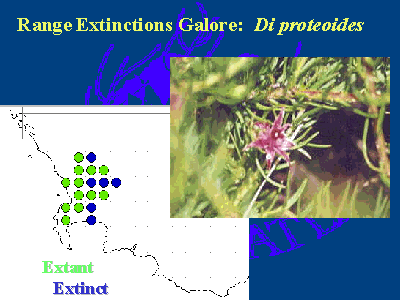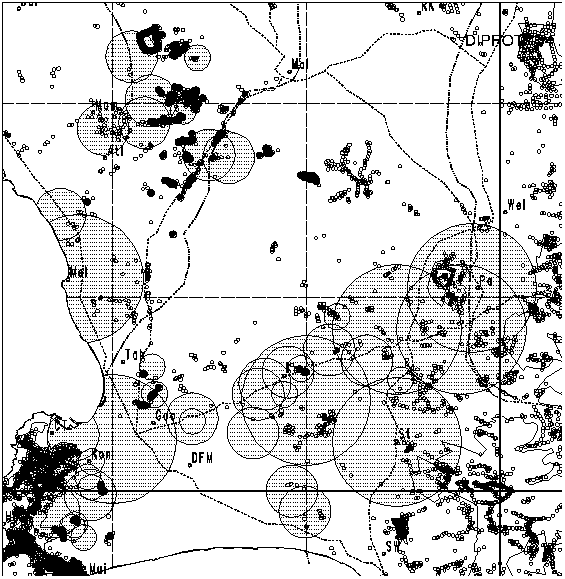 The
down side of all our data is that some species do not occur where the herbarium records
suggest that they should.
Instead of finding Diastella proteoides in many areas of the Cape Flats we find
that there habitat is no longer there- houses, farms and plantations occur instead. Out of
18 Grid Squares only 12 still have this species - a 30% reduction in range?
Not true!
A detailed map of Di proteoides is shown below. Note that the open dots are
areas visited by atlassers. The filled in dots are areas with Di prot present. The
larger circles are herbarium records (the size of the circles indicates how accurate the
herbarium locality is - larger circles or vague, smaller more precise). Note that the
black area at the Helderberg Nature Reserve (just above SW or Somerset West) is not a
locality for this species, but intense sampling.

The situation for Di prot is far worse than the Grid Square data suggest. The
species is extinct east of Bellville. The atlas records from near Kraaifontein are from a
population that was developed into a site and service scheme for squatters at Kraaifor -
none of these plants have a future! The plants north of Goodwood (Goo) were mowed by
ESCOM, so that there future is bleak (we hope that there are seeds present to regenerate
this species - but if ESCOM keeps mowing these then they will go extinct - the unmowed
patch is too small to keep a viable population going). There are only a few plants in the
Kenilworth Race Course, two plants in the Meadowridge Commonage and a few have been
planted into Rondevlei Nature Reserve. Only the Tokai Forest population appears to have a
secure future.
Effectively this means that Diastella proteoides is extinct in more than 66% of
its historical localities, and in those that it survives, there is only one secure place
within the Greater Cape Town Metropolitan Area! Highlighting again the fact that the city
of Cape Town is one of the Megadisaster Areas in the world for the loss of biodiversity.
Note though that the species appears secure south-west of Malmesbury and that we have
even discovered some new populations.
But all was not plain sailing with regard to Atlassing - we also had some problems. |

![]()

